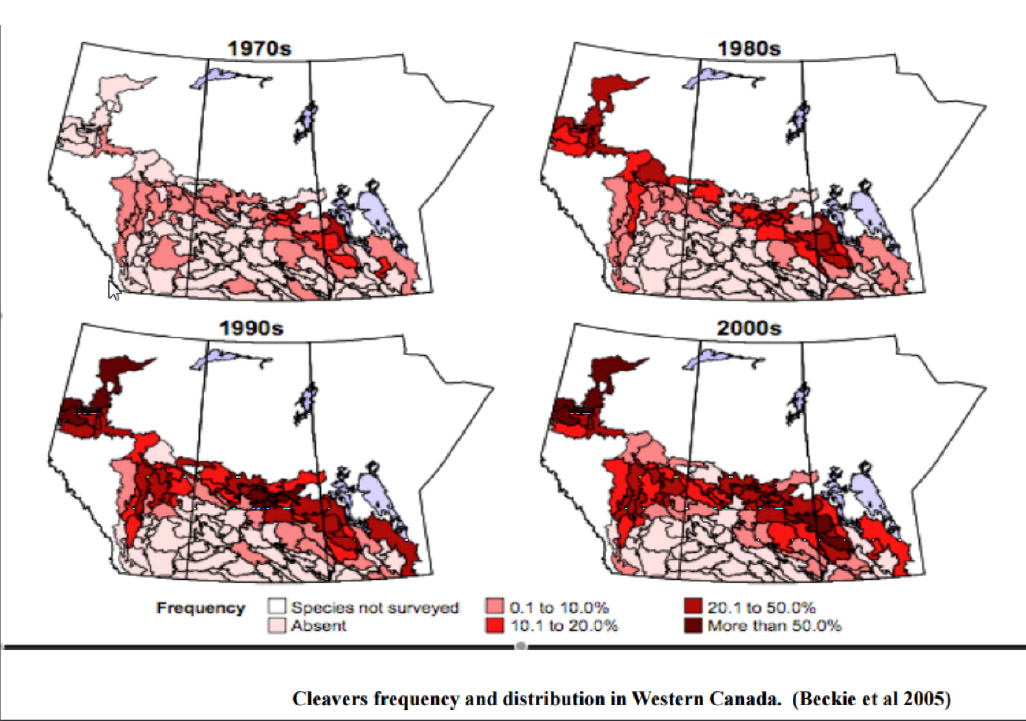By Thom Weir, Senior Precision Agronomist
Last time I addressed a weed that I called the “scourge of the south”. For the northern farmers, this week I will discuss “the scourge of the north,” commonly known as cleavers. Just as we saw a significant increase in the acres infested with kochia, we have seen cleavers spread across agricultural soils in the black and neighbouring soil zones.
Cleavers refers to two closely related species – Galium aparine and Galium spurium (a.k.a. false cleavers). It is a very competitive weed.
There have been several theories about the spread of this disease. It’s “sticky” nature caused by the fine spines on the stems cause the weed to stick to anything it touches. Deer and geese have been blamed for cleavers dispersal. The fact that the seed is almost identical in size may also have led to farmers inadvertently planting cleavers when seed was open pollinated or when “brown bagged” canola was planted. Whatever the reason, cleavers are wide spread across the dark brown, black and grey wooded soil zones.
Cleavers grow both as a winter annual and a spring annual weed. Over the years, whether it was due to a selection of hardier biotypes, warmer winters or other cultural shifts, there seems to be a higher number of weeds surviving our winters. These cleavers are quite easily controlled with a shot of glyphosate in the fall but like many winter annuals, seem to be harder to control in the spring. As many populations of cleavers are Gr. 2 resistant, the use of a non-Gr. 2 add-in product with glyphosate is warranted when over-wintering populations are observed. These may include but are not restricted to products such as Heat, Conquer or CleanStart.
As mentioned above, there are populations of cleavers that are Gr. 2 resistant. It has now got to the stage that if you have cleavers, you should consider them resistant to Gr. 2 products. With these tools out of our toolbox, managing cleavers just became a whole lot harder. Within cereals, fluoxypyr containing products have been the product of choice. However, it should be noted that there are populations of cleavers that are resistant to both Gr. 2 and Gr. 4 herbicides! Seeds can be sent away to provincial crop protection labs for resistance testing if resistance is suspected.
Growing crops like peas has become very troublesome with the increase in Group 2 resistant cleaver biotypes. IMI chemistry alone is no longer effective and products containing bentazon (e.g. Viper) only claim suppression. Products containing sulfentrazone (Authority® or Authority® Charge) control cleavers if applied as a pre-emergent product before the emergence of the peas. Ethalflurin (Edge) will also provide suppression or marginal control of cleavers.
With Canola, glyphosate (Roundup) provides the most consistent control of cleavers. However, under heavy pressures or when winter annual populations have been poorly controlled, the high rate or a second application should be made. Glufosinate (Liberty) is marginal at controlling cleavers with a single pass. When using this product, use 2 applications and use the maximum rate on the label. Both products work best on small cleavers so plan to scout and spray your canola early. Clearfield Canola is not advised if you have a cleavers problem as there are no alternatives to Gr. 2 products in this system.
Quinclorac (e.g. Clever®) is a Gr. 4 product that provides excellent cleavers control in canola, especially when tank mixed with glufosinate or glyphosate. While registered on canola, maximum residue limits (MRLs) have not been established for quinclorac in China so the use of this product is not recommended at this time.
Clomazone (e.g. Command) is a group 13 soil applied herbicide, which will provide early residual control of cleavers. It can be applied pre-seed with a glyphosate burn-off application and works with all herbicide tolerant canola. Clomazone reduces the initial flush of cleavers, reducing the pressure on in-crop herbicides which improve control of cleavers. Clomazone is registered for pre-plant application in canola and leaves no detectable residue on seed, oil or meal.
There are several products registered with multiple modes of action for cereals. Where possible, use one of the products containing fluoxypyr when targeting cleavers and use the maximum labeled rate for the chosen product. A product like Infinity FX which contains three modes of action (none of which is Gr. 2) is an excellent choice.
As stated before, some of the strategies to follow in the battle against cleavers are:
- Use a varied approach including fall and pre-seeding burn off products.
- Use the maximum labelled rates for in-season products.
- Tank mix or use pre-mixed products that contain multiple control products for cleavers.
- Use multiple applications of products where the label allows.
- Avoid using Gr. 2 products if you suspect you may have a resistance issue.
- Spray early as products are most effective on young cleaver plants.


